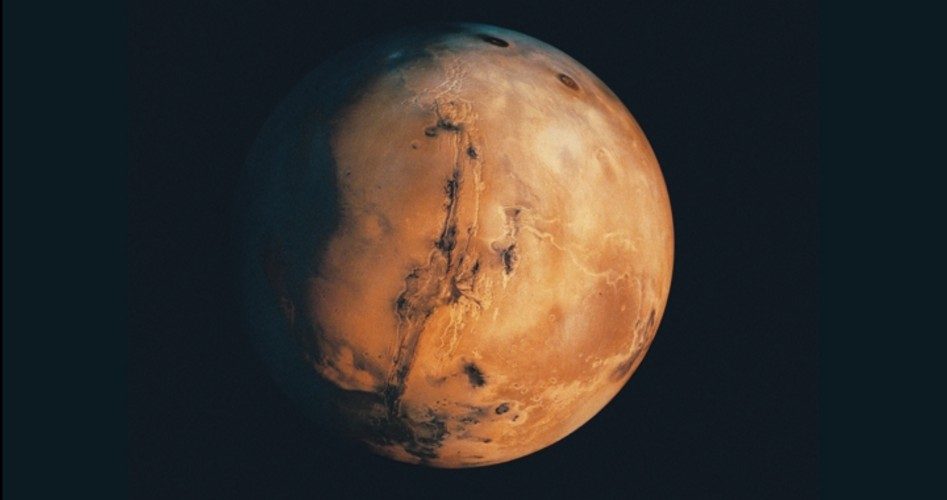
As the Curiosity rover continues its travels across the Martian surface, the Red Planet is back in the news, with information linking that world’s distant past to a possible future. Whatever secrets may be uncovered in the next several years by the science teams which direct the work of the current rover, Mars continues to draw human interest and imagination in a way no other object in the night sky is able to equal.
The prospect of discovering past or present life on Mars has inevitably been attached in public expectations to NASA’s Mars Science Laboratory, the $2.5-billion rover which has been given the name of Curiosity, and the popular media has become accustomed to connecting a “life on Mars” angle to almost every report regarding that mission. Thus, for example, when project scientist John Grotzinger declared concerning a discovery, the details of which had not yet been disclosed, “This data is gonna be one for the history books. It’s looking really good,” the media began to speculate that Curiosity had discovered signs of past Martian life. But, as the Guardian (U.K.) reported, while a great many scientific experiments are being conducted by the rover, it is not primarily on the Martian surface to search for evidence of life:
By the time the story reached the pages of the U.K.’s Daily Express, it had turned into: “Nasa are set to reveal what could be the most significant scientific discovery in modern times, teasingly stating they have unearthed something on Mars ‘for the history books.'”
Whatever Curiosity has found, it is not evidence for life on Mars. It can’t be. Curiosity is not designed to look for life. Grotzinger has stated this himself. In a Nasa video about the mission, he says, “Curiosity is not a life detection mission. We’re not actually looking for life; we don’t have the ability to detect life if it was there.”
Following up the internet speculation, Jeffrey Kluger of Time talked to Nasa’s Jet Propulsion Laboratory spokesperson Guy Webster and was told, “It won’t be earthshaking, but it will be interesting.“
Other research, such as that which is being conducted at the University of Western Ontario, continues looking for areas on the surface of Mars which might be analogous to environments which support life on Earth. According to an article for Space.com, small springs could exists in the northern reaches of the Red Planet which could hypothetically offer potential habitat for forms of life similar to those found in similar springs in the Canadian arctic:
Researchers probed the makeup of several salt-laden pools in the arctic permafrost, similar to salt environments that spacecraft orbiting Mars have spotted on the Red Planet. The arctic pools contain microbial life, and could give primitive life a haven if they exist on Mars, researchers say.
“On Mars, we don’t know if there are any springs, but the environment is essentially completely permafrost. So these springs are potential analogs for present-day Mars,” said Gordon Osinski, a University of Western Ontario assistant professor who has expertise in planetary geology.
The work is led by Melissa Battler, a Ph.D. candidate at the university, with Osinski supervising. …
But if the springs exist on Mars, the researchers said they could support microbial life. Because salt keeps the water warm in freezing temperatures, researchers found microbes in the Arctic springs even though the surrounding ground is permafrost.
In the Northwest Territories, Battler also analyzed a spring containing jarosite, a mineral that forms in water. This mineral is particularly exciting to researchers because on Mars, the Spirit and Opportunity rovers both found it as well.
The research by Osinski and Battler is particularly interesting because it is undertaken with the expectation that the Martian climate is not radically cooler than in past ages; in other words, if life once existed in such hypothetical springs, it could still be alive.
However, for all of the scientific and popular interest in past or present life on Mars, what can awaken the greatest public reaction is the possibility of future, human life on Mars. With both the old and new media spotlight turned once more toward Mars, Elon Musk, the entrepreneur who created SpaceX, has given further hints regarding his plans for a future human settlement on Mars. Musk is no idle dreamer: His company holds the contract with NASA to resupply the International Space Station, and SpaceX’s Dragon capsule is capable of taking a crew or supplies to destinations far beyond low Earth orbit. The successful return on October 28 of the first such resupply mission demonstrated that SpaceX is a company which delivers on its promises. And the company’s CEO is promising much more. As Emi Kolawole wrote recently for the Washington Post, Musk envisions an outpost of human civilization on another world within the next few decades:
The Space Explorations (SpaceX) founder revealed more of his vision for a future colony on the Red Planet in an appearance at the Royal Aeronautical Society in London on Nov. 16 and in an interview with Space.com contributor Rob Coppinger. The colony, which Musk says he would like to be a public-private joint venture (far from alien territory for Musk’s SpaceX) would have up to 80,000 inhabitants. The first group of adventurers would include fewer than 10 people, with each paying $500,000 for the ride on a reusable rocket fueled by liquid oxygen and methane.
The first colonists would land with equipment to begin generating crops, leveraging the nitrogen and carbon dioxide in the Martian atmosphere as well as subsurface ice. According to Musk, the venture would require approximately $36 billion in funding.
Musk feels that the beginning of such a colony need not wait for the distant future; he hopes to see a human being on Mars in “12 to 15 years.” And, although previous government-funded schemes for sending humans to Mars have quickly been abandoned as the presidents come and go in Washington, a substantial involvement in such an endeavor by corporations with the technology, resources, and willpower to accomplish such an end could open a new frontier.
When it comes to Mars, much of what humanity wants to know about the past remains hidden, and what may come to pass remains in the realm of speculation. But for the scientists and engineers who study the fourth planet in our solar system, another world is seemingly less and less alien every year.
Photo of Mars



